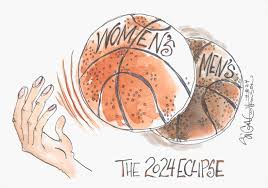1
Section One: The Fundamentals
A) What do we know about sport? What are common assumptions we make about sport and society?
|
I believe that sports build a lot of character. Sports build character by teaching important skills like self-control, working hard, working with others, being respectful, and setting goals. Athletes learn how to face challenges, cooperate with teammates, and handle winning and losing in a positive way. These lessons help people become stronger, more responsible, and honest, and these qualities apply to life outside of sports too. I this category of sports building character there was a comment in regards to the negative side of this statement that really stood out to me. As I agree the sports do build and create character in a person someone stated that the negative side to self esteem and confidence is also present. I also agree with this comment that was made by this peer.
|
Exercise 3: Notebook prompt
What are some other metanarratives about sport that you are familiar with? Find an image or video clip or draw something yourself that captures this idea…
So what? Why does any of this matter? Does it matter? As something we grow up with – live with – play through – we don’t often interrogate the meanings of sport, and perhaps we don’t want to.
But being aware of these assumptions and metanarratives is especially important, I would argue, because of the centrality of sport to our everyday lives, the role that sport plays in shaping our childhood and worldviews and….. [finish that thought]
| –Sports as Entertainment :. Sports has increasingly been framed as entertainment, focusing on profits, media consumption, and celebrity culture. This narrative shifts the focus from the intrinsic values of sport to its commercial aspects, often overshadowing the deeper meaning behind the sports The “sport as entertainment” idea sees sports mainly as a fun show for people to watch, often for making money. It changes how we think about sports, focusing less on things like teamwork, skill-building, and community, and more on making profits, selling media, and attracting fans.
But being aware of these assumptions and metanarratives is especially important, I would argue, because of the centrality of sport to our everyday lives, the role that sport plays in shaping our childhood and worldviews and….. Sport affects how we think about things like success, working together, competition, and even how we view men and women. Being aware of these ideas helps us think more critically about the messages sports give us and lets us question harmful stereotypes or unfair treatment that can come from sports culture.
|
B) What is social justice?
Exercise 4: Padlet Prompt
Think back to the last section and try to look at some of the ideas we discussed differently. How might sport and social justice actually co-exist?
Record any images, video clips, or gifs you added to the padlet and identify a point of intersection between sport and social justice (can be an issue or a barrier or a debate or something you would like to explore in more depth in this course) . Screenshot or paste in your response below.
| Promoting Equality and Inclusion: Sports can be a space where everyone, regardless of race, gender, sexuality, or ability, is given equal opportunities to participate. For example, initiatives like women’s sports leagues, disability-inclusive sports, or anti-racism campaigns in sports can help create a more inclusive environment.
The barrier between male and female sports is still something that is very known in sports. I would like to look more in depth on this topic and this barrier and how it can be changed. I believe men and women’s sports are equal and should be looked at and treated the same.
|
C) Social Justice Reading
(note: this activity is optional!)
D) KINESIOLOGY AND SOCIAL JUSTICE
Exercise 5:
Exercise 6:
What are the implications of bodies-at-risk discourse and the refusal to understand the health gap from a social justice perspective, according to the authors of this article?
|
According to the authors in the article they argue that the bodies-at-risk discourse and the refusal to view the health gap through a social justice lens have negative implications. The artucle explains when certain groups are called “at-risk,” it often blames them for their health problems without considering the bigger issues like poverty, racism, or lack of access to healthcare. This way of thinking ignores the larger, systemic causes of health inequality. The authors call for a social justice framework to better understand and address health disparities, focusing on systemic issues and creating more inclusive, effective solutions.
|
Section Two: Sport Feminism
Exercise 7: Notebook Prompt
What is feminism? What does it mean to you? Choose one of the images below and explain how it captures your understanding of feminism (or find one that does speak to you and paste this into your pressbook with an explanation of why it matters to you.
| Feminism is about fighting for equal rights for all genders, especially women. It aims to make sure everyone has the same chances and is treated fairly, no matter their gender. For me, feminism means standing up for equality and making sure people aren’t held back because of who they are or what society expects them to be.
The one picture that spoke to me was the cartoon of the women holding her muscles up and saying “We can do it”. This picture is a strong woman stating that she can do it even though she is a women. Women can do what men do. It is very empowering and shows womens strengths and how strong women are.
|
Exercise 8: Notes Prompt (optional)
NB: Cornell notes is a great resource that teaches effective notetaking. Unfortunately, our system can’t save notes taken in the H5P app, so this is fully optional.
Exercise 9: Crossword Activity
Exercise 10: Padlet Prompt
| GENDER IDENTITY SPORT DISCRIMINATIONFEMINISM POWER EQUALITY OPPORTUNITY PATRIARCHY
|

|
|

